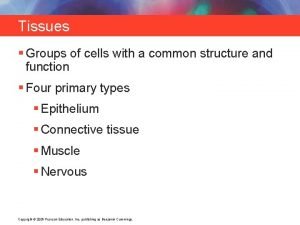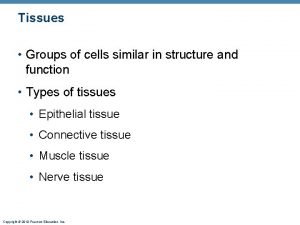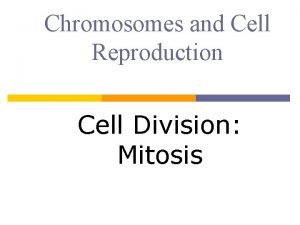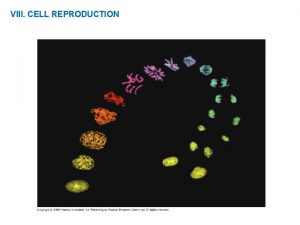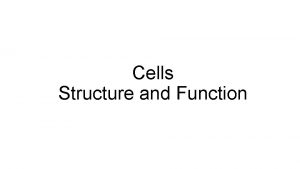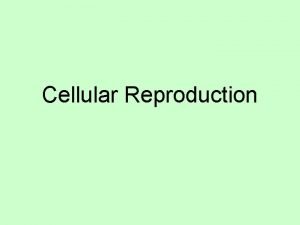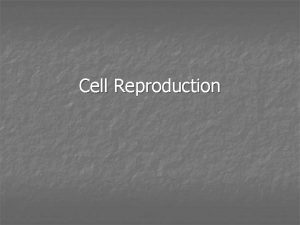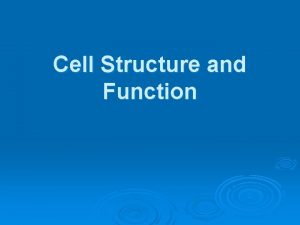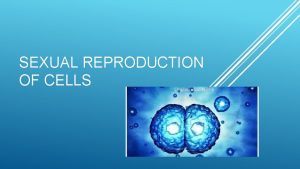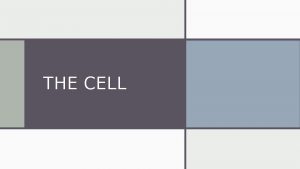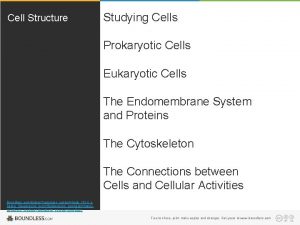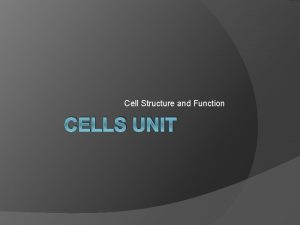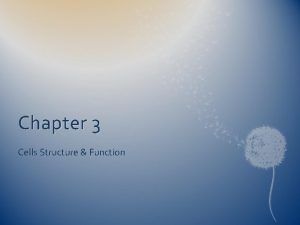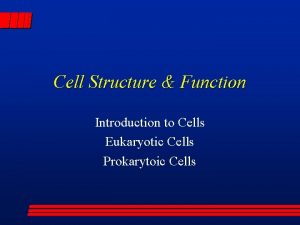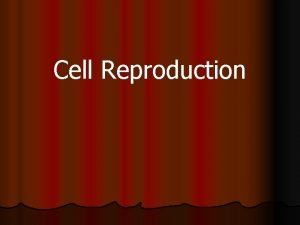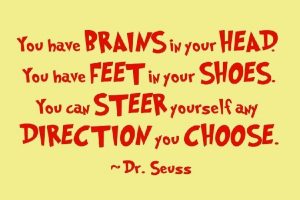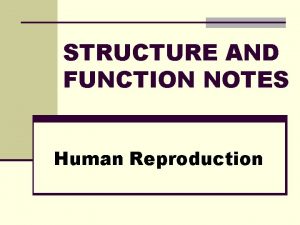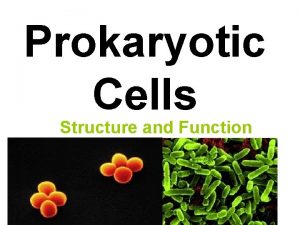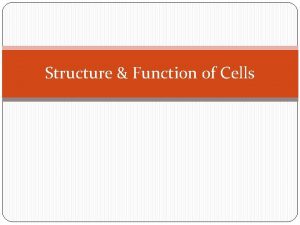Cell Structure Function Cells Cell Reproduction Day 1



























- Slides: 27

Cell Structure & Function

Cells & Cell Reproduction Day 1 Objective: SWBAT Describe the cell theory and differentiate between prokaryotic and eukaryotic cells IA: Cell’s pretest

Cell Theory • All living things are made up of cells. • Cells are the smallest working units of all living things. • All cells come from preexisting cells through cell division.

Definition of Cell A cell is the smallest unit that is capable of performing life functions.

Two Types of Cells • Prokaryotic (Single Cell Organisms) • Eukaryotic (Multi Cellular Organisms)

Prokaryotic • Do not have structures surrounded by membranes • Few internal structures • One-celled organisms, Bacteria http: //library. thinkquest. org/C 004535/prokaryotic_cells. html

Eukaryotic • Contain organelles surrounded by membrane • Most living organisms Plant http: //library. thinkquest. org/C 004535/eukaryotic_cells. html Animal

“Typical” Animal Cell http: //web. jjay. cuny. edu/~acarpi/NSC/images/cell. gif

“Typical” Plant Cell http: //waynesword. palomar. edu/images/plant 3. gif

Cells and Cell Reproduction Day 3 • Objective: SWBAT compare and contrast the different parts of the and plant cell • IA:

Surrounding the Cell

Cell Membrane • Outer membrane of cell that controls movement in and out of the cell • Double layer • Found in both Plant and Animal Cells http: //library. thinkquest. org/12413/structures. html

Cell Wall • Most commonly found in plant cells & bacteria • Supports & protects cells • NOT FOUND IN ANIMAL CELLS. http: //library. thinkquest. org/12413/structures. html

Inside the Cell

Nucleus • Directs cell activities • Separated from cytoplasm by nuclear membrane • Contains genetic material – DNA • Like the “brain” of the cell

Nuclear Membrane • Surrounds nucleus • Made of two layers • Openings allow material to enter and leave nucleus http: //library. thinkquest. org/12413/structures. html

Chromosomes • In nucleus • Made of DNA • Contain instructions for traits & characteristics http: //library. thinkquest. org/12413/structures. html

Nucleolus • Inside nucleus • Contains RNA to build proteins http: //library. thinkquest. org/12413/structures. html

Cytoplasm • • Gel-like mixture Surrounded by cell membrane Contains hereditary material Fills in space in the cell

Endoplasmic Reticulum • Moves materials around in cell • Smooth type: lacks ribosomes • Rough type (pictured): ribosomes embedded in surface http: //library. thinkquest. org/12413/structures. html

Ribosomes • Each cell can contain thousands of ribosomes • Make proteins http: //library. thinkquest. org/12413/structures. html

Mitochondria • Produces energy through chemical reactions – breaking down fats & carbohydrates • Controls level of water and other materials in cell • Recycles and decomposes proteins, fats, and carbohydrates

Golgi Bodies • Protein 'packaging plant‘ • Move materials within the cell • Move materials out of the cell http: //library. thinkquest. org/12413/structures. html

Lysosome • Digestive system for proteins, fats, and carbohydrates • Transports undigested material to cell membrane for removal • Cell breaks down if lysosome explodes http: //library. thinkquest. org/12413/structures. html

Vacuoles • Membrane-bound sacs for storage, digestion, and waste removal • Contains water solution • Help plants maintain shape http: //library. thinkquest. org/12413/structures. html

Chloroplast • Usually found in plant cells • Contains green chlorophyll • Where photosynthesis takes place http: //library. thinkquest. org/12413/structures. html

Activity: Foldable • Draw a picture of an animal cell • Label all of the parts and write the definition • Draw a picture of a plant cell • Label all the parts but write the definition for the parts only found in the plant cell
 Chapter 8 cellular reproduction cells from cells
Chapter 8 cellular reproduction cells from cells Day 1 day 2 day 3 day 4
Day 1 day 2 day 3 day 4 Venn diagram of sexual and asexual reproduction
Venn diagram of sexual and asexual reproduction Sexual reproduction and asexual reproduction
Sexual reproduction and asexual reproduction Sexual and asexual reproduction in animals venn diagram
Sexual and asexual reproduction in animals venn diagram Day 1 day 2 day 817
Day 1 day 2 day 817 Groups of cells with a common structure and function.
Groups of cells with a common structure and function. Group of cells that are similar in structure and function
Group of cells that are similar in structure and function A group of cells similar in structure and function
A group of cells similar in structure and function Paranasal sinus development
Paranasal sinus development Alpha intercalated cells
Alpha intercalated cells Thyroid gland
Thyroid gland How are somatic cells different from gametes
How are somatic cells different from gametes Somatic vs germ cells
Somatic vs germ cells Red blood cells and white blood cells difference
Red blood cells and white blood cells difference Eukarya
Eukarya Animal rights and animal welfare venn diagram
Animal rights and animal welfare venn diagram Prokaryotes vs eukaryotes venn diagram
Prokaryotes vs eukaryotes venn diagram Cell organelle jeopardy
Cell organelle jeopardy Masses of cells form and steal nutrients from healthy cells
Masses of cells form and steal nutrients from healthy cells Pseudostratified vs simple columnar
Pseudostratified vs simple columnar Are plant cells prokaryotic or eukaryotic
Are plant cells prokaryotic or eukaryotic Which organisms are prokaryotes
Which organisms are prokaryotes Cell substance
Cell substance Function of the cell wall
Function of the cell wall Cell reproduction
Cell reproduction Mitosis sexual reproduction
Mitosis sexual reproduction Cell cycle and replication
Cell cycle and replication






